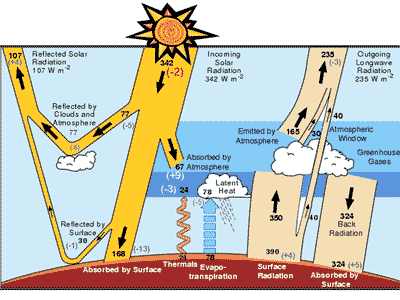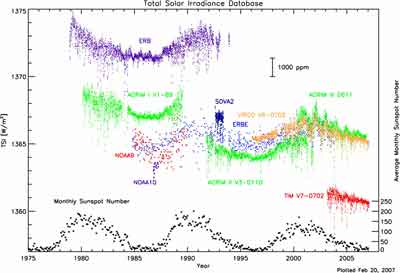Science
The Sun is the dominant energy source driving the Earth’s climate system and has both direct and indirect influences on the terrestrial system. The TIM’s measurement of the total solar irradiance arriving at the top of the Earth’s atmosphere is 1361 W/m2, providing a globally averaged value of 340 W/m2 (see Earth Energy Balance Figure below based on Kiehl and Trenberth [1997] and adapted from a presentation by Bill Collins, NCAR, at the 2006 SORCE Science Team Meeting). This external energy input, minus losses caused by the Earth’s planetary albedo, is balanced by a global infrared emittance corresponding to an average Earth atmosphere temperature of 254 K (-19° C). The external energy input in combination with surface and atmospheric processes, most notably the effects of water vapor and other greenhouse gases, equilibrate to a global mean surface temperature of 288 K (15° C).

Schematic depiction of global energy flows in the Sun-Climate system by Kiehl and Trenberth (Bull. Am. Meteor. Soc., 1997).
Quantities in parenthesis indicate changes in global heat flows in 10 years of Community Climate System Model (CCSM) research. The -2 associated with incoming solar radiation is based on SORCE TIM results of 1361 Wm-2. This figure is adapted from a presentation by Bill Collins, NCAR, given at the 2006 SORCE Science Team Meeting.
Precise space measurements obtained during the past 3 decades imply that the TSI varies on the order of 0.1% over the 11-year solar cycle, but with greater variations on day-to-month scales due to solar rotation and the passage of sunspots and facular regions across the solar disk. Variations in TSI occur over time scales from minutes to 11-year solar cycles and longer. Climate models including a sensitivity to solar forcing estimate a global climate change of up to 0.2° C due to solar variations over the last 150 years.
To determine long-term changes in the Sun’s output, which may have time scales extending much longer than the 11-year solar cycle, the TSI climate record requires either very good absolute accuracy or very good instrument stability and continuous measurements. To date, no TSI instrument has achieved the necessary absolute accuracy, and the TSI record relies on measurement continuity from overlapping spacecraft instruments (see TSI Database Figure below). The SORCE/TIM instrument continues the 3-decade long climate record of spaceborne TSI measurements. The TIM has an estimated absolute accuracy of 350 ppm, where 1 ppm = 0.0001%, and a long-term repeatability for detecting relative changes in solar irradiance of 10 ppm per year.
For more details, see Kopp, G., Lawrence, G., and Rottman, G., “The Total Irradiance Monitor (TIM): Science Results,” Solar Physics, 230, 1, Aug. 2005, pp. 129-140.




